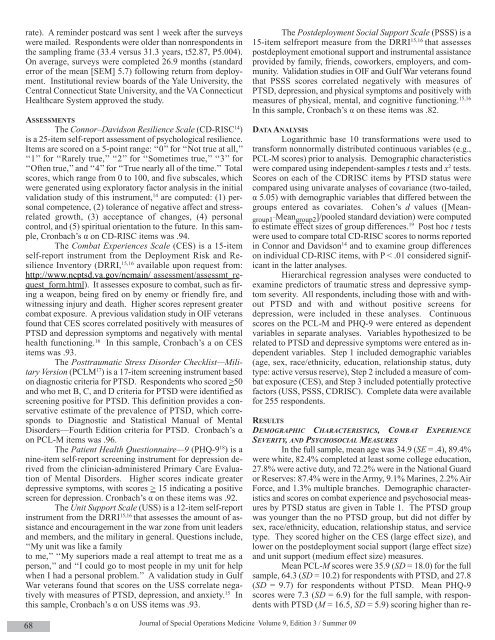Summer - United States Special Operations Command
Summer - United States Special Operations Command
Summer - United States Special Operations Command
Create successful ePaper yourself
Turn your PDF publications into a flip-book with our unique Google optimized e-Paper software.
ate). A reminder postcard was sent 1 week after the surveyswere mailed. Respondents were older than nonrespondents inthe sampling frame (33.4 versus 31.3 years, t52.87, P5.004).On average, surveys were completed 26.9 months (standarderror of the mean [SEM] 5.7) following return from deployment.Institutional review boards of the Yale University, theCentral Connecticut State University, and the VA ConnecticutHealthcare System approved the study.ASSESSMENTSThe Connor–Davidson Resilience Scale (CD-RISC 14 )is a 25-item self-report assessment of psychological resilience.Items are scored on a 5-point range: ‘‘0’’ for ‘‘Not true at all,’’‘‘1’’ for ‘‘Rarely true,’’ ‘‘2’’ for ‘‘Sometimes true,’’ ‘‘3’’ for‘‘Often true,’’ and ‘‘4’’ for ‘‘True nearly all of the time.’’ Totalscores, which range from 0 to 100, and five subscales, whichwere generated using exploratory factor analysis in the initialvalidation study of this instrument, 14 are computed: (1) personalcompetence, (2) tolerance of negative affect and stressrelatedgrowth, (3) acceptance of changes, (4) personalcontrol, and (5) spiritual orientation to the future. In this sample,Cronbach’s α on CD-RISC items was .94.The Combat Experiences Scale (CES) is a 15-itemself-report instrument from the Deployment Risk and ResilienceInventory (DRRI, 15,16 available upon request from:http://www.ncptsd.va.gov/ncmain/ assessment/assessmt_request_form.html).It assesses exposure to combat, such as firinga weapon, being fired on by enemy or friendly fire, andwitnessing injury and death. Higher scores represent greatercombat exposure. A previous validation study in OIF veteransfound that CES scores correlated positively with measures ofPTSD and depression symptoms and negatively with mentalhealth functioning. 16 In this sample, Cronbach’s a on CESitems was .93.The Posttraumatic Stress Disorder Checklist—MilitaryVersion (PCLM 17 ) is a 17-item screening instrument basedon diagnostic criteria for PTSD. Respondents who scored >50and who met B, C, and D criteria for PTSD were identified asscreening positive for PTSD. This definition provides a conservativeestimate of the prevalence of PTSD, which correspondsto Diagnostic and Statistical Manual of MentalDisorders—Fourth Edition criteria for PTSD. Cronbach’s αon PCL-M items was .96.The Patient Health Questionnaire—9 (PHQ-9 18 ) is anine-item self-report screening instrument for depression derivedfrom the clinician-administered Primary Care Evaluationof Mental Disorders. Higher scores indicate greaterdepressive symptoms, with scores > 15 indicating a positivescreen for depression. Cronbach’s α on these items was .92.The Unit Support Scale (USS) is a 12-item self-reportinstrument from the DRRI 15,16 that assesses the amount of assistanceand encouragement in the war zone from unit leadersand members, and the military in general. Questions include,‘‘My unit was like a familyto me,’’ ‘‘My superiors made a real attempt to treat me as aperson,’’ and ‘‘I could go to most people in my unit for helpwhen I had a personal problem.’’ A validation study in GulfWar veterans found that scores on the USS correlate negativelywith measures of PTSD, depression, and anxiety. 15 Inthis sample, Cronbach’s α on USS items was .93.The Postdeployment Social Support Scale (PSSS) is a15-item selfreport measure from the DRRI 15,16 that assessespostdeployment emotional support and instrumental assistanceprovided by family, friends, coworkers, employers, and community.Validation studies in OIF and Gulf War veterans foundthat PSSS scores correlated negatively with measures ofPTSD, depression, and physical symptoms and positively withmeasures of physical, mental, and cognitive functioning. 15,16In this sample, Cronbach’s α on these items was .82.DATA ANALYSISLogarithmic base 10 transformations were used totransform nonnormally distributed continuous variables (e.g.,PCL-M scores) prior to analysis. Demographic characteristicswere compared using independent-samples t tests and x 2 tests.Scores on each of the CDRISC items by PTSD status werecompared using univarate analyses of covariance (two-tailed,α 5.05) with demographic variables that differed between thegroups entered as covariates. Cohen’s d values ([Meangroup1_ Mean group2 ]/pooled standard deviation) were computedto estimate effect sizes of group differences. 19 Post hoc t testswere used to compare total CD-RISC scores to norms reportedin Connor and Davidson 14 and to examine group differenceson individual CD-RISC items, with P < .01 considered significantin the latter analyses.Hierarchical regression analyses were conducted toexamine predictors of traumatic stress and depressive symptomseverity. All respondents, including those with and withoutPTSD and with and without positive screens fordepression, were included in these analyses. Continuousscores on the PCL-M and PHQ-9 were entered as dependentvariables in separate analyses. Variables hypothesized to berelated to PTSD and depressive symptoms were entered as independentvariables. Step 1 included demographic variables(age, sex, race/ethnicity, education, relationship status, dutytype: active versus reserve), Step 2 included a measure of combatexposure (CES), and Step 3 included potentially protectivefactors (USS, PSSS, CDRISC). Complete data were availablefor 255 respondents.RESULTSDEMOGRAPHIC CHARACTERISTICS, COMBAT EXPERIENCESEVERITY, AND PSYCHOSOCIAL MEASURESIn the full sample, mean age was 34.9 (SE = .4), 89.4%were white, 82.4% completed at least some college education,27.8% were active duty, and 72.2% were in the National Guardor Reserves: 87.4% were in the Army, 9.1% Marines, 2.2% AirForce, and 1.3% multiple branches. Demographic characteristicsand scores on combat experience and psychosocial measuresby PTSD status are given in Table 1. The PTSD groupwas younger than the no PTSD group, but did not differ bysex, race/ethnicity, education, relationship status, and servicetype. They scored higher on the CES (large effect size), andlower on the postdeployment social support (large effect size)and unit support (medium effect size) measures.Mean PCL-M scores were 35.9 (SD = 18.0) for the fullsample, 64.3 (SD = 10.2) for respondents with PTSD, and 27.8(SD = 9.7) for respondents without PTSD. Mean PHQ-9scores were 7.3 (SD = 6.9) for the full sample, with respondentswith PTSD (M = 16.5, SD = 5.9) scoring higher than re-68Journal of <strong>Special</strong> <strong>Operations</strong> Medicine Volume 9, Edition 3 / <strong>Summer</strong> 09
















